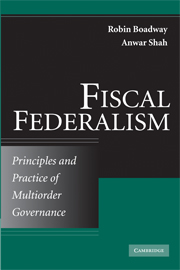Book contents
- Frontmatter
- Contents
- Preface
- PART ONE DESIGNING FISCAL CONSTITUTIONS
- PART TWO REVENUE SHARING AND FISCAL TRANSFERS
- 8 Revenue Sharing
- 9 The Principles of Intergovernmental Transfers
- 10 The Practice of Intergovernmental Transfers
- PART THREE FINANCE AND PROVISION OF PUBLIC SERVICES
- PART FOUR CHALLENGES AND RESPONSES
- References
- Index
8 - Revenue Sharing
Published online by Cambridge University Press: 05 June 2012
- Frontmatter
- Contents
- Preface
- PART ONE DESIGNING FISCAL CONSTITUTIONS
- PART TWO REVENUE SHARING AND FISCAL TRANSFERS
- 8 Revenue Sharing
- 9 The Principles of Intergovernmental Transfers
- 10 The Practice of Intergovernmental Transfers
- PART THREE FINANCE AND PROVISION OF PUBLIC SERVICES
- PART FOUR CHALLENGES AND RESPONSES
- References
- Index
Summary
The vertical fiscal gap (VFG) in a federation reflects the difference between revenue means and expenditure needs of states. This gap is usually filled by the revenues raised by the federal government that are made available to the states to finance their expenditures. There are two broad ways this transfer of funds can take place: by assigning a predetermined share of federal revenues to the states, or by making federal-state transfers whose magnitude is based on criteria other than federal revenues. The first is revenue sharing, which is the subject of this chapter, while the second falls under the general rubric of federal-state transfers. The distinction is a conceptual one only, because they both amount to a transfer of funds, and both share some common characteristics. Nonetheless, the term revenue sharing tends to refer to a specific method of calculating transfers to the states according to the sharing of federal revenues, so we follow common practice in treating them as separate entities.
The structure of revenue-sharing systems varies by country, and it is useful to set out a taxonomy of forms. One feature that most revenue-sharing systems share is that the transfers involved are typically unconditional. That is, their use is at the discretion of the state governments that receive them. This is by no means a necessary feature of revenue sharing but one that is commonly used. Revenue sharing is usually only one component of a broader system of transfers.
- Type
- Chapter
- Information
- Fiscal FederalismPrinciples and Practice of Multiorder Governance, pp. 293 - 305Publisher: Cambridge University PressPrint publication year: 2009



